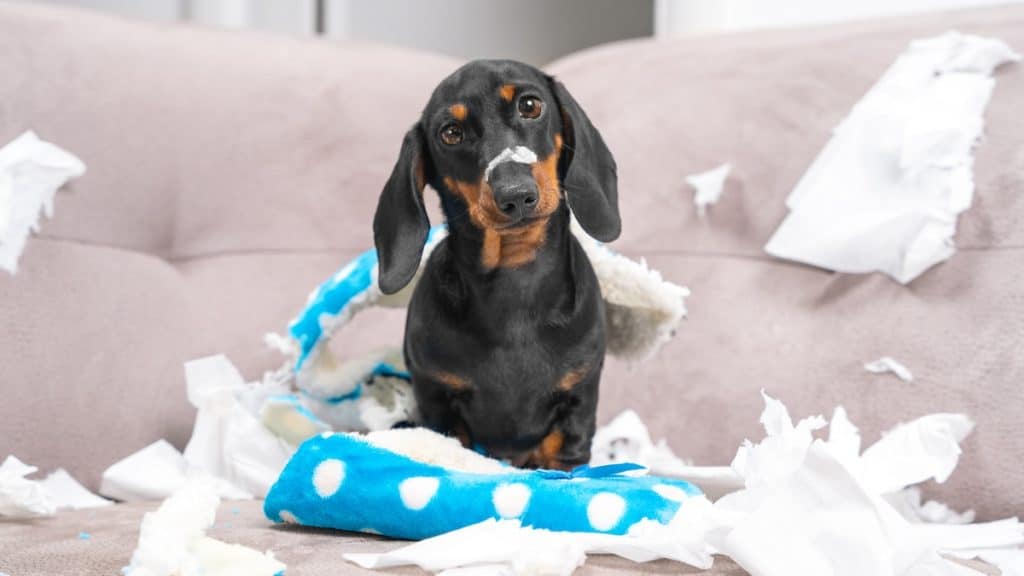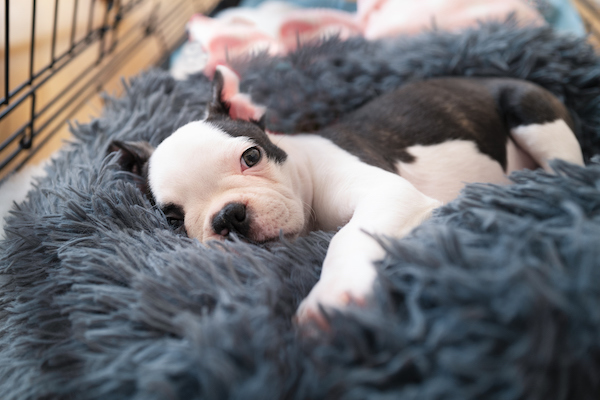- This post contains affiliate links. Read more here.
As most new pet parents know, working out how long you can leave your puppy alone can be a stressful proposition. You worry for their happiness, their safety, and the safety of your belongings. A set of ground rules can help take the anxiety out of knowing how and when to leave your puppy on their own.
The general rule of thumb for how long you can leave a puppy alone is one hour per month of age. But you’ll also want to take other factors into account, including where they’re at with potty training and what kind of experience they’ve had with separation so far.
We spoke to Dr. Jordan Beauchamp, DVM and Medical Director at GoodVets, to learn more.
Age & Time Guidelines
Older dogs (at least one year in age) can typically be home alone for up to six hours, but a puppy should be let outside and checked on more frequently. Exactly how often depends on their age, how long they can cope emotionally with being alone, and how often they need to potty.
Experts typically recommend a schedule like this:
-
- 8–10 weeks: Less than 30 minutes
-
- 10–12 weeks: 30 minutes to one hour (depending on if your puppy is in their fear period)
-
- 3–6 months: One hour per month of age
-
- After 6 months: One hour per month of age, with six hours max for well-adjusted older puppies
Leaving a Puppy Alone for the First Time
If your pup is at least eight weeks old and adjusting well to their new environment, it’s time to start leaving them alone for short periods of time. Here’s what to do.
-
- Feed, exercise, and let your puppy out to potty. Food, water, and a potty break are slam dunks. But enrichment is equally important to keep a puppy from becoming bored and destructive on their own. Before you leave, try a training session, a walk around the neighbourhood, a puzzle feeder, or a round of indoor games to help your puppy settle.
-
- Turn on white noise or the TV. Gentle background noise, especially if you live in a busy city or flat, can help reduce alarm barking at sudden noises.
-
- Have your puppy move into their crate or pen. If your puppy’s crate training is progressing well, you can leave them in their crate. Otherwise, consider setting up a puppy pen with a cosy blanket or an old shirt with your scent, a dog bed, and potty pads. Pro-Tip: Monitor your dog before leaving them alone with toys, since puppies can chew and swallow small parts.
-
- Get some practice in before you leave for real. Don’t start by leaving your puppy alone for a full 30 minutes. Instead, consider working up to it with some short practice departures to see how your pup handles it. A pet camera can help you monitor your puppy’s reactions.

iStock/Ирина Мещерякова
Training Your Puppy To Be Alone
If your puppy is having a hard time adjusting to being alone, separation training can help. The goal is to practice leaving for tiny periods, working up to longer ones in a way that doesn’t traumatise your new friend. Pushing the issue faster than your pup is ready can lead to more serious issues down the road, like puppy separation anxiety.
Here’s what to do.
1. Work on crate training
If your puppy doesn’t relax in their crate while you’re at home, they probably aren’t relaxed when you’re away. Revisit crate training until you’re sure your puppy can happily spend time in their crate. When they feel comfortable in their crate, you’ll be in a better place to start increasing how long you can leave your puppy alone.
Check that the crate is the right size, then work on building positive associations by feeding your puppy there and offering chews, toys, and treats when they’re in it. You can also try some crate games.
2. Set a separation training schedule
To help your puppy learn to be alone, you might need to take things slowly. Try a schedule like this:
-
- Days 1-3: Start getting your puppy used to your departures by settling them in their space, then stepping out of view for a few seconds at a time. A “stay” cue can help. Practice consistently until you can leave for a minute without signs of distress.
- Days 4-7: Start adding time to your departures, just a few seconds each time. If your puppy shows signs of distress, back up a little to where they’re comfortable once more.
- Days 8-14: Keep adding time until you can leave your puppy for 10, 15, and then 30 minutes, advancing once your pup is comfortable.
Some puppies might be just fine being left alone in a matter of days, but others will need longer to adjust. Patience and going at your puppy’s pace are key.
3. Look into stress-reducing products
A pheromone diffuser, such as the Adaptil pheromone diffuser, may help reduce stress by releasing a calming pheromone for your dog. Some people may also consider calming supplements for their dog.
Your vet is a good resource for any supplements you’re considering adding to your dog’s diet, and for more serious conversations about anxiety medications if problems persist.
Factors That Impact Your Puppy’s Ability To Be Alone
While most puppies find separation to be an adjustment, there are factors that can make it easier or harder. Here’s what influences a dog’s ability to be alone.
Age
The younger the dog, the less training they’ve had. A puppy who is eight weeks old, for example, will likely have a harder time being on their own than a puppy who is eight months old. While bouts of regression happen, your puppy should make significant progress over time.
Breed
Certain breeds, such as Shiba Inus and Malteses, tend to acclimate to alone time quickly due to their independent natures. High-energy breeds, such as Border Collies, Golden Retrievers, and Huskies, may require extra exercise before being alone. German Shepherds, Samoyeds, and other social dogs may need a slower, trainer-informed approach to succeed.
Potty training
According to Dr. Beauchamp, housetraining is a key factor in how long you can leave your puppy alone. “Leaving a puppy for too long, too early has the potential to set back potty training,” she says. “Puppies require a consistent schedule, and I suggest being regimented about taking them out every 2 to 3 hours. Some smaller breeds may even need to go out more frequently.”
Feeding routine
Puppies who are not yet six months old require between 3 and 6 meals per day. If you leave a hungry puppy alone, it could cause your pet to associate separation with stress. No matter your dog’s life stage, it’s important to plan for their feeding schedule when you’re going to be away.
Environmental distractions
If your dog’s crate is situated by a busy window, for example, they may remain on high alert and have trouble settling down. Consider using a sound machine and a crate cover to create a stress-free environment.

CBCK-Christine via iStock
Signs To Take Alone Training Slower
When it comes to how long you can leave your puppy alone, your puppy won’t be shy about letting you know you’re trying to increase that time too rapidly. Separation anxiety can be stressful on both puppy and human. If your dog continually exhibits the below behaviours when left alone, it’s time to slow down training and seek support.
-
- Excessive barking, screaming, or whining
-
- Trying to escape their crate
-
- Self-biting/self-harm
-
- Urinating or defecating in the crate
If your puppy’s separation distress isn’t going away or is leading them to self-harming behaviours, it’s a good idea to rule out underlying medical issues with a visit to your vet.
If your puppy gets a clean bill of health, consider reaching out to a credentialed trainer, especially a behaviourist. They can help you identify the causes of your puppy’s anxiety and come up with a plan—both for managing things in the present and getting them back on the right track.
How To Work 9 to 5 with a Puppy
While some pet parents may work remotely with their puppy, others may need to spend the workday outside the house. Until your puppy is old enough to be alone for the workday, you’ll want to find alternate care solutions. That might involve hiring a dog walker or looking into doggy daycare. Some doggy daycares also provide training sessions, which can be a huge advantage.
If you need to leave your puppy overnight, make sure to have a trustworthy sitter in place. While a dog walker is perfect for drop-ins during the day, a puppy should always have constant overnight care.
And while you’re expending all this energy on your new friend, make sure to take care of yourself too—when the puppy blues strike, getting away for a little bit can do you both good!


